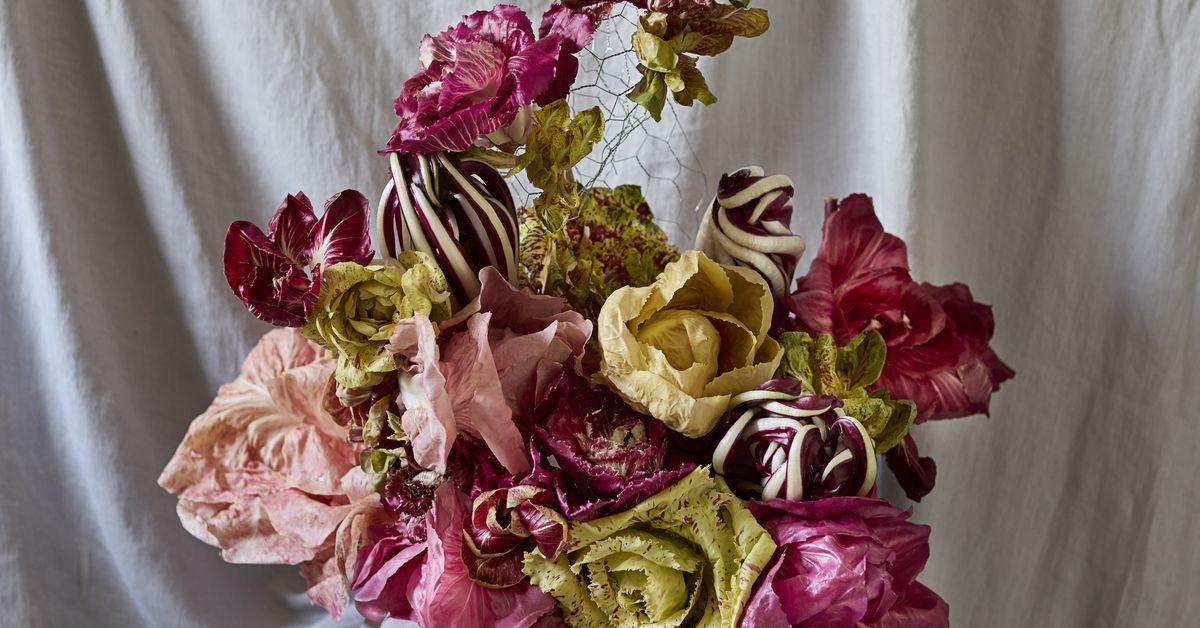
[ad_1]
Not very long in the past, I went to a mushroom-themed musical dinner. The entire meal highlighted mushrooms, from the white snow fungus in the welcome beverages to the shiitakes in the sweet mushroom pavlova (astonishingly great!). The natural way, ahead of any dishes even strike the desk, mushrooms appeared there as well frilly clusters of oyster mushrooms anchored preparations that ended up or else sparsely poked with greenery and just a flower or two. It introduced to lifetime what I’d been lengthy coveting on my Instagram feed: bouquets designed up generally of greens and mushrooms, with bouquets current but getting a supporting role.
The most prominent case in point of this is the Los Angeles floral designer Yasmine Mei, who describes her function as “playfully combining the classical and the uncommon.” Her preparations include things like pomegranates surrounding pink oysters and pom poms of lion’s mane, fluffy tufts of flowers interspersed with enokis, and thick trumpets nestled into a bouquet with herbs. A design and style that includes mushrooms alongside with underripe tangerines and stalks of yellow grevillea, also known as spider bouquets, gives an otherworldly appearance. Her arrangements are owning a second, appearing at a modern event by Salad Freak writer Jess Damuck and at another with designer Stella McCartney. “You, way too, can fungify your centerpiece,” Smallhold, the fast growing provider whose mushrooms are frequently made use of artistically, wrote in an Instagram article sharing Mei’s arrangement.
It isn’t just mushrooms starring in these refreshingly unpredictable styles. A splash of white currants convert a single pitcher plant into a centerpiece in an arrangement from London florist Kasia Borowiecka, who has also made use of tropical fruit, as perfectly as kale and bitter melon, to terrific textural influence. Sparse styles from the Limassol, Cyprus artist Anastasia Kolesnichenko uncover sculptural natural beauty in preparations as straightforward as a single star fruit paired with a slice of citrus and two flowers so do types from Berlin floral designer Carolin Ruggaber, who anchors arrangements with grapes or lemons. A “nutso midcentury Christmas kitsch spread” by the foods artist Jen Monroe and the brand House & Functions integrated a tower of white asparagus, wrapped with pink ribbons. These aren’t your regular Edible Preparations, but artwork that highlights the magnificence in what transpires to be edible.
Natoora, the purveyor of specialty generate, will make a persuasive scenario for the vegetable bouquet each and every Valentine’s Day. With its “Radicchio, Not Roses” marketing campaign, Natoora argues that not only are roses wasted at the stop of their lives, but the approach of producing them is typically exploitative and environmentally unsustainable, requiring shipping in excess of large distances and transportation on a lot more useful resource-intensive refrigerated vehicles. Radicchio, by comparison, can be eaten just after staying enjoyed visually.
What I like about the produce-centric bouquet is the crack from expectation. There is however a put for bouquets, of system, but it’s a way of on the lookout past the noticeable (flowers alone) and to the a lot more appealing (bizarre greens, pleasurable fruit) and what it can increase. A further gain, at minimum for a modest arrangement: As a result of Natoora, a bunch of Rosa Del Veneto — that hyper-fashionable radicchio whose lush pink leaves resemble a peony — would at present run me just less than $10 each individual a dozen roses from 1-800-Flowers is $50. This Valentine’s Working day, most likely it is time to skip the occupied flower store and do the bulk of your bouquet accumulating at the farmers current market.
[ad_2]

